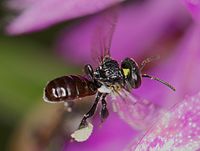
Photo from wikipedia
Besides the incipient research effort, the role of parasites as drivers of the reduction affecting pollinator populations is mostly unknown. Given the worldwide extension of the beekeeping practice and the… Click to show full abstract
Besides the incipient research effort, the role of parasites as drivers of the reduction affecting pollinator populations is mostly unknown. Given the worldwide extension of the beekeeping practice and the diversity of pathogens affecting Apis mellifera populations, honey bee colonies are a certain source of parasite dispersion to other species. Here, we communicate the detection of the microsporidium Nosema ceranae, a relatively new parasite of honey bees, in stingless bees (Meliponini) and the social wasp Polybia scutellaris (Vespidae) samples from Argentina and Brazil by means of duplex PCR. Beyond the geographic location of the nests, N. ceranae was detected in seven from the eight Meliponini species analyzed, while Nosema apis, another common parasite of A. mellifera, was absent in all samples tested. Further research is necessary to determine if the presence of the parasite is also associated with established infection in host tissues. The obtained information enriches the current knowledge about pathologies that can infect or, at least, be vectored by native wild pollinators from South America.
Journal Title: Microbial Ecology
Year Published: 2017
Link to full text (if available)
Share on Social Media: Sign Up to like & get
recommendations!